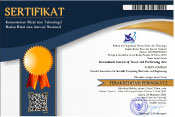(2) Silvester Pamardi
(3) Joko Aswoyo
*corresponding author
AbstractArtistic research on community empowerment through artistic innovation in the Ceprotan Ceremony in Sekar Village aims to explain how the steps for optimizing performing arts innovations at the Ceprotan ceremony are through village community empowerment strategies. The initial step of this artistic research was carried out by direct observation to obtain data and information regarding the myths and practices of the Ceprotan Ceremony. In addition, to obtain more in-depth data, the researcher used the participant observer strategy and, at the same time, conducted in-depth interviews. The results of this investigation are then used by researchers to develop a community empowerment-based artistic innovation model. The results of this community empowerment-based artistic research are (1) systematic performance management; (2) the creation of social cohesion in the series of Ceprotan performances; (3) the identity of the village of Sekar is formed; (4) the revitalization of the Sekar Taji dance drama; (5) the reduction of bad events or trance (possession). The contribution of this research is an example for other regions that want to use artistic innovation as the formation of village identity and, at the same time, as an effort to complement and advance the cultural potential of Sekar Village
KeywordsPerforming arts innovations; Ceprotan ceremony; Empowering rural communities
|
DOIhttps://doi.org/10.31763/viperarts.v4i2.865 |
Article metrics10.31763/viperarts.v4i2.865 Abstract views : 1164 | PDF views : 446 |
Cite |
Full Text Download Download
|
References
[1] J. Aswoyo and S. Sularso, “The Concept of Panutan in Governance Festival Lima Gunung in Magelang Central Java Indonesia,†Harmon. J. Arts Res. Educ., vol. 20, no. 1, pp. 1–9, Jun. 2020, doi: 10.15294/harmonia.v20i1.24818.
[2] A. Bhattacharya and M. Dutta, “Empowering Heritage Entrepreneurs: An Experience in Strategic Marketing,†J. Herit. Manag., vol. 7, no. 2, pp. 186–199, Dec. 2022, doi: 10.1177/24559296221120471.
[3] L. Richmond and L. Casali, “The role of social capital in fishing community sustainability: Spiraling down and up in a rural California port,†Mar. Policy, vol. 137, p. 104934, Mar. 2022, doi: 10.1016/j.marpol.2021.104934.
[4] C. L. Costigan, J. T. Taknint, E. Mudryk, and B. Al Qudayri, “Building community: Connecting refugee and Canadian families,†Cult. Divers. Ethn. Minor. Psychol., vol. 28, no. 3, pp. 338–348, Jul. 2022, doi: 10.1037/cdp0000428.
[5] G. Grabher, “Ecologies of Creativity: The Village, the Group, and the Heterarchic Organisation of the British Advertising Industry,†Environ. Plan. A Econ. Sp., vol. 33, no. 2, pp. 351–374, Feb. 2001, doi: 10.1068/a3314.
[6] D. T. N. Nguyen, A.-M. D’Hauteserre, and S. Serrao-Neumann, “Intrinsic barriers to and opportunities for community empowerment in community-based tourism development in Thai Nguyen province, Vietnam,†J. Sustain. Tour., vol. 30, no. 4, pp. 723–741, 2022, doi 10.1080/09669582.2021.1884689.
[7] Q. Wang, D. Ogilvie, and L. Richardson, “Race/ethnicity, place, and art and culture entrepreneurship in underserved communities,†Cities, vol. 115, pp. 1–10, Aug. 2021, doi: 10.1016/j.cities.2021.103243.
[8] W. Nitzky, “Community Empowerment at the Periphery? Participatory Approaches to Heritage Protection in Guizhou, China,†in Cultural Heritage Politics in China, New York, NY: Springer New York, 2013, pp. 205–232. doi: 10.1007/978-1-4614-6874-5_11
[9] J. Anwar McHenry, “Rural empowerment through the arts: The role of the arts in civic and social participation in the Mid West region of Western Australia,†J. Rural Stud., vol. 27, no. 3, pp. 245–253, Jul. 2011, doi: 10.1016/j.jrurstud.2011.03.001.
[10] R. D. Putnam, “Social Capital and Public Affairs,†Bull. Am. Acad. Arts Sci., vol. 47, no. 8, pp. 5–19, May 1994, doi: 10.2307/3824796.
[11] B. Balfour, M. W-P Fortunato, and T. R. Alter, “The creative fire: An interactional framework for rural arts-based development,†J. Rural Stud., vol. 63, pp. 229–239, Oct. 2018, doi: 10.1016/j.jrurstud.2016.11.002.
[12] K. Scott, F. Rowe, and V. Pollock, “Creating the good life? A wellbeing perspective on cultural value in rural development,†J. Rural Stud., vol. 59, pp. 173–182, Apr. 2018, doi: 10.1016/j.jrurstud.2016.07.001.
[13] M. Ciesielska, K. W. Bostrom, and M. Ohlander, “Observation Methods,†in Qualitative Methodologies in Organization Studies, Cham: Springer International Publishing, 2018, pp. 33–52. doi: 10.1007/978-3-319-65442-3_2
[14] A. MartıÌnez, Y. Dimitriadis, B. Rubia, E. Gómez, and P. de la Fuente, “Combining qualitative evaluation and social network analysis for the study of classroom social interactions,†Comput. Educ., vol. 41, no. 4, pp. 353–368, Dec. 2003, doi: 10.1016/j.compedu.2003.06.001.
[15] W. C. Adams, “Conducting Semi-Structured Interviews,†in Handbook of Practical Program Evaluation, Hoboken, NJ, USA: John Wiley & Sons, Inc., 2015, pp. 492–505. doi: 10.1002/9781119171386.ch19
[16] J. W. Pennebaker, “Writing About Emotional Experiences as a Therapeutic Process,†Psychol. Sci., vol. 8, no. 3, pp. 162–166, May 1997, doi: 10.1111/j.1467-9280.1997.tb00403.x.
[17] H. G. Barnett, “Anthropology is the designer’s conception of what constitutes anthro,†in The Teaching of Anthropology, no. 94, Univ of California Press, 1963, p. 373.
[18] H. L. Stuckey and J. Nobel, “The Connection Between Art, Healing, and Public Health: A Review of Current Literature,†Am. J. Public Health, vol. 100, no. 2, pp. 254–263, Feb. 2010, doi: 10.2105/AJPH.2008.156497.
[19] M. W. Notoatmodjo, Gotong-rojong in Indonesian administration, a concept of human relations. Indiana University, 1962.
[20] N. Cantor, “Life Task Problem Solving: Situational Affordances and Personal Needs,†Personal. Soc. Psychol. Bull., vol. 20, no. 3, pp. 235–243, Jun. 1994, doi: 10.1177/0146167294203001.
[21] M. Csikszentmihalyi, “Toward a Psychology of Optimal Experience,†in Flow and the Foundations of Positive Psychology, Dordrecht: Springer Netherlands, 2014, pp. 209–226. doi: 10.1007/978-94-017-9088-8_14
[22] G. V. Sarah L. Holloway, “Children’s geographies and the new social studies of childhood,†in Children’s Geographies, Routledge, 2004, pp. 16–37. doi: 10.4324/9780203017524-11
Refbacks
- There are currently no refbacks.
Copyright (c) 2022 Miftakhul Khoiriah, Silvester Pamardi, Joko Aswoyo

This work is licensed under a Creative Commons Attribution-ShareAlike 4.0 International License.
___________________________________________________________
International Journal of Visual and Performing Arts
ISSN 2684-9259
Published by Association for Scientific Computing Electronics and Engineering (ASCEE)
W: http://pubs2.ascee.org/index.php/viperarts
E: sularso@ascee.org
Organized by:
 This work is licensed under a Creative Commons Attribution-ShareAlike 4.0
This work is licensed under a Creative Commons Attribution-ShareAlike 4.0
























